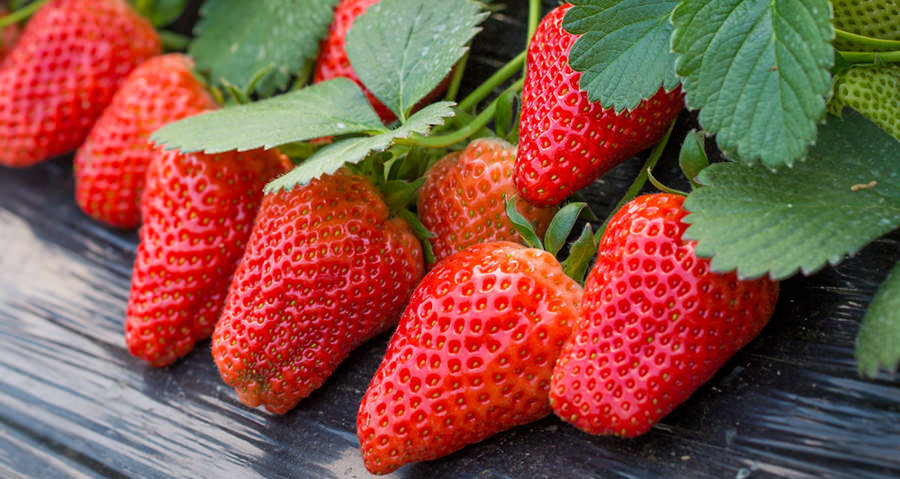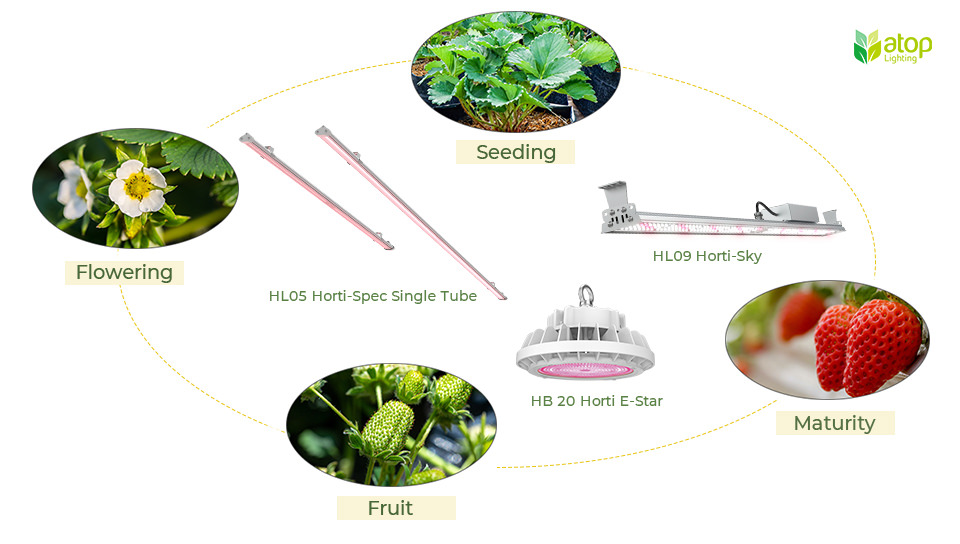Tips for Growing Strawberry Effectively with Greenhouse
Strawberries are appreciated for their vibrant red color, juicy texture, and delicious flavor. They are also rich in vitamin and manganese, which are beneficial to our health. Though strawberries are available all year round due to the globalization, locally-grown and fresh strawberries are only available in limited periods. Greenhouse provides an opportunity to break out of weather and location limitations for growing strawberries. Advanced harvest, higher production and yields, and better quality of strawberries enable growers reap more profits. However, growing strawberries in greenhouse can also be a challenge for growers. Growers should have abundant knowledge of the optimum environment factors (such as temperature, lighting and humidity) for strawberries production and the ways to achieve them. This post will show some tips including site selection, cultivar, and environment factors to help you grow strawberry more effectively with greenhouse.

Site selection
Site selection is critical as it is associated with sunlight, ventilation, soil, and water. Greenhouse should be located in an area that is full of sunlight to gain adequate lights. Shading is also an important point because it is related to light intensity. We should note that greenhouse cannot shaded by surrounding buildings or trees. Otherwise, we may need more supplement lights even in sunny days. An area with good ventilation prevent overheat and extra cost of cooling for greenhouse. Good ventilation helps to prevent pest and disease in certain degree as well. The area with well drained sandy or loam soils are great for strawberry growing as the roots require aeration. Raised beds are recommended as they let soil warmer and increase drainage. To avoid extra diseases, strawberries are not allowed to grow in the soils that had cultivated tomatoes, peppers, potatoes or eggplants. Modern greenhouses grow strawberry in grow bags on the top of the ground generally. Proper drainage of grow bags is essential to provide well drained but not over wet soils. A site near water supply makes irrigation and cleaning more convenient.
Strawberry classification
Fruiting habits are varied from the types of strawberry and it is vital for marketing. If growers want to earn more profits by selling strawberries at higher price, cultivar with advanced production may work. Strawberries are classified into June-bearing strawberries, everbearing strawberries and day-neutral strawberries, according to their flowering habits. Jun-bearing strawberries flower in short day periods and initiate to bear fruit in June (early summer). Everbearing strawberries have two harvests, June and late summer. They produce flowers during long day periods and bear a small crop in the first harvest with a more plentiful harvest in the next. Day-neutral strawberries have similar production patterns with everbearing strawberries, so sometimes day-neutral strawberries are grouped to everbearing strawberries. The main difference is day- neutral strawberries produce flowers as long as temperatures are between 2 °C to 29.5 °C. Back to the topic about the type of strawberries for price premiums, June-bearing strawberries are excellent as they can achieve about 4 weeks earlier production than traditional open field strawberries.
Flowering habits of strawberries are relative with day-length sensitivity and the type of photoperiod. After knowing the classification of strawberries, we can operate the right supplement lighting for them.
Temperature & humidity
To grow strawberries more effectively, temperature and humidity in greenhouse should be maintained with optimal value during the whole production. Temperatures between 18 to 24 ℃ in day time and 10 to 13 ℃ at night are beneficial for plant growing. For the root or crown, temperature about 18 ℃ is the greatest. Higher day temperature and lower night temperature can improve the flavor of strawberries. Relative humidity inside the greenhouse in day time should be 60% to 70% while it could be up to 90% or even 95% at night. Higher night humidity accelerates calcium uptake and nutrient transfer. In contrast, low humidity will cause tipburn, which is negative to fruit quality.
Here is a table about recommended temperature and humidity for greenhouse strawberries.
|
Growth Factors |
Temperature |
Humidity |
||
|
Recommended Value
|
Day |
Night |
Day |
Night |
|
18 - 24 ℃ |
10 - 13 ℃ |
60% - 70% |
90% - 95% |
|
Lighting
Lighting is irreducible for plants. Plants absorb sunlight and transform to energy for their growth. LED grow lights are used for supplying lighting under insufficient sunlight conditions, such as winter or cloudy days. Supplemental lighting is conductive to induce flowering and earlier harvest timing. When it comes to lighting requirements of strawberries, DLI (Daily Light Integral), lighting quality, and the effects of different wavelength of LED grow lights should be taken into account.
DLI means the total photosynthetic active photons (400-700 nm) being absorbed by plants in a square meter over a day (24 hours). DLI is measured in mol·m¯²·d¯¹. A minimum DLI level of 12 mol·m¯²·d¯¹ is suitable for runner growth and fruit production of strawberry plant. DLI of 15 to 25 mol·m¯²·d¯¹ is optimum for greenhouse strawberries.
Relative factors of light quality are the type of photoperiodic and lighting intensity. Photoperiodic lighting can boost flowering as flowering habits of some strawberries are affected by the length of day times. LED grow lights are capable of extending or shortening the day length. Researches have shown that 8 hours photoperiod for short-day plants and 16 hours photoperiod for long-day plants could trigger earlier flowering. To target flowering, lighting intensity in the range of 2 to 3 µmol·m¯²·s ¯¹ over plants is ideal.
Effects of different wavelength of LED light are measured on various aspects. UV light, blue light, red light, and the combination of blue light and red light have leading impacts on strawberry plant growth. UV light is good for forming attractive color of fruit through increasing anthocyanin content. Blue light is effective in increasing leaflet length during vegetative stage but less effective in formatting sugar. Red light has greater impact on accumulating phenolic compounds in the fruit while having lesser effects on the formation of anthocyanin. The combination of blue and red light, however, achieve the highest fruits production compared to other LED lights.
Several LED growl lights are typically designed for greenhouse strawberries. Atop provides HL05 Horti-Spec Single Tube, HL09 Horti-Sky, and HB20 Horti E-Star LED grow lights to accelerate flowering and improve production. HL05 Horti-Spec Single Tube is designed for vertical farms with full spectrum and optional length, being able to used for all growing stages. HL09 Horti-Sky helps to balance crop quality and yield by providing precise and uniform supplemental lighting. HB20 Horti E-Star has smaller, lighter appearance but powerful output. It can replace 250W or 400W traditional HPS or MH lights. All LED grow lights from Atop are available with customized spectrum. Please feel free to contact us and find more info. 

